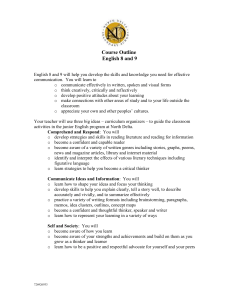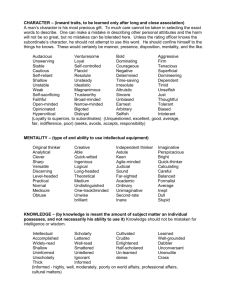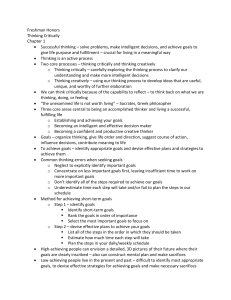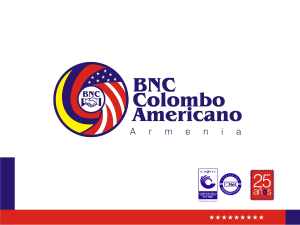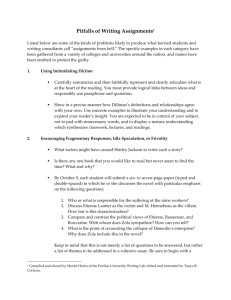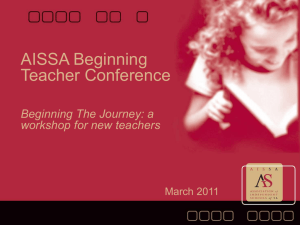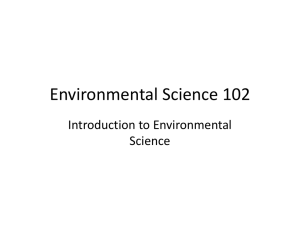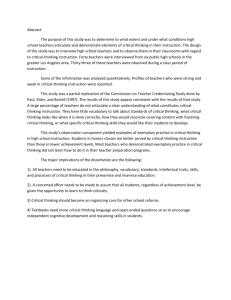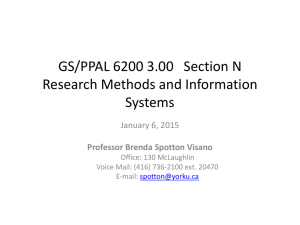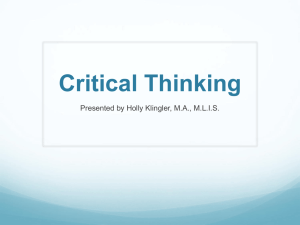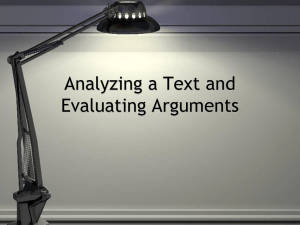Thinking Critically: The Basis of a College Education chapter
advertisement
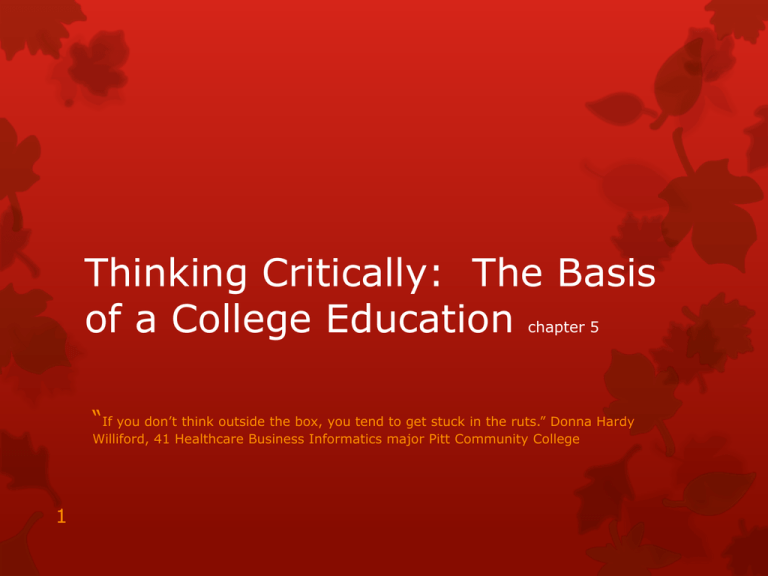
Thinking Critically: The Basis of a College Education chapter 5 “If you don’t think outside the box, you tend to get stuck in the ruts.” Donna Hardy Williford, 41 Healthcare Business Informatics major Pitt Community College 1 In This Chapter You Will Explore Why critical thinking is essential for success The meaning and value of a liberal education Why there are no “absolutely right” or “positively wrong” answers to important questions How to sharpen your critical-thinking skills How logical reasoning can help you make sense of conflicting ideas 2 Your Turn : Group Discussion In your own words define liberal education. Why would a “free” mind be an asset for you now and in the future. 3 Critical Thinking Check Assessing your strengths: Critical thinking is one of the most valuable skills you can practice for success in college and in the workplace. Are you a good critical thinker? Now that you have read the first section of this chapter, list specific examples of your strengths in critical thinking. 4 Setting Goals: What are your most important objectives in learning in this chapter? Do you know the difference between critical thinking and “being critical”? List three goals that relate to developing and practicing critical-thinking skills (This week I will watch one TV news show, such as Meet the Press, The O’Reilly Factor, or The Daily Show, and make a list of “facts” I question and why). What Is Critical Thinking, and Why Is It Important? Your Turn On the basis of the explanation above, how would you rate yourself as a critical thinker? 5 Your Turn Think of a problem you had to solve in the past. How did you do it? How can you draw on that experience to improve your ability to solve academic problems? Becoming a Critical Thinker ASK Questions Consider Multiple Points of View Draw Conclusions 6 DID YOU KNOW? 54% of first-year students say they “frequently evaluate the quality or reliability of information they receive.” 7 Your Turn Imagine that your state has just approved a license plate design incorporating a cross and the slogan “I Believe.” Almost immediately, a number of organizations begin protesting that this is a violation of the First Amendment of the U.S. Constitution. What kinds of questions will you ask ask to get at the truth? 8 Your Turn If you never have worked with a study group, now is the time to try it and discover how much more learning can take place in a shorter period of time. How do you think you could benefit from joining a study group? What reasons might you give for not joining one? 9 How Collaboration Fosters Critical Thinking Get a Second Opinion One way to become a better critical thinker is to practice with other people. By getting feedback from another person, you can see the possible flaws in your own position. You will also learn that there are few black-andwhite answers to any question. 10 Thinking Critically about Arguments Challenge Assumptions Examine The Evidence 11 Your Turn So far, what unstated assumptions do you see in Richard’s argument? Explain why you might question some of his claims. What’s the difference between Richard’s approach to the truth and Sally’s? Which is more sensible? Why? In your opinion, is hosting the Olympics good or bad for a city? Why? How can you reconcile Richard's views on the subject with Sally’s findings? If you think the truth lies in between, how would you go about discovering it? What, if anything, is wrong with making decisions purely on the basis of your emotions? 12 Beware of Logical Fallacies False Advertising: Advertisers know that the public can be easily influences to buy a product promoted by a famous athlete. Before admitting to using performance enhancing drugs, cyclist Lance Armstrong endorsed everything from shoes to athletic equipment to beer. Good critical thinkers evaluate products on their merits, not their advertising. 13 Beware of Logical Fallacies: Have you ever used any of these fallacies to justify a decision? Why was it wrong to do so? Can you think of other errors of logic that might push you farther from the truth? Here are some common missteps people make in use of logic: Attacking the person. Begging. Appealing to false authority. Jumping on a bandwagon. Assuming that something is true because it hasn’t been proven false. Falling victim to false causes. Making hasty generalizations. 14 Critical Thinking in College and Everyday Life Your Turn: Suppose you’re shopping for a surrounding sound system. One good friend urges you to buy the top of the line. Another well-meaning friend steers you to a different brand, claiming it’s just as good as the more expensive brand leader. Now all you know is that two of your good friends have offered information might not be true. How do you think critically about which system to choose? 15 Checklist For Success: Make sure you understand what critical thinking means. Find ways to express your imagination and curiosity; practice asking questions. Challenge your own and other’s assumptions that are not supported by evidence. During class lectures, presentations, and discussions, practice thinking about the subjects being discussed from multiple points of view. 16 Critical Thinking Draw your own conclusions, and explain to others what evidence you considered that led you to these positions. Join study groups of class project teams, and work as a team member with other students. Learn to identify false claims in commercials and in political arguments. Practice critical thinking not only in your academic work but also in your everyday interactions with friends and family. Build Your Experience Stay on Track One-Minute Paper Applying What You Have Learned Building Your Portfolio 17 Complete the activity on pge. 98-99 Read and complete Activity pg. 100 Begin Reading Chapter 6,7,8 Review PowerPoints on D2L. Reference Gardner, J. & Barefoot, B (2012) Your College Experience: Strategies for Success Bedford/St. Martin’s Ed 10th 18
